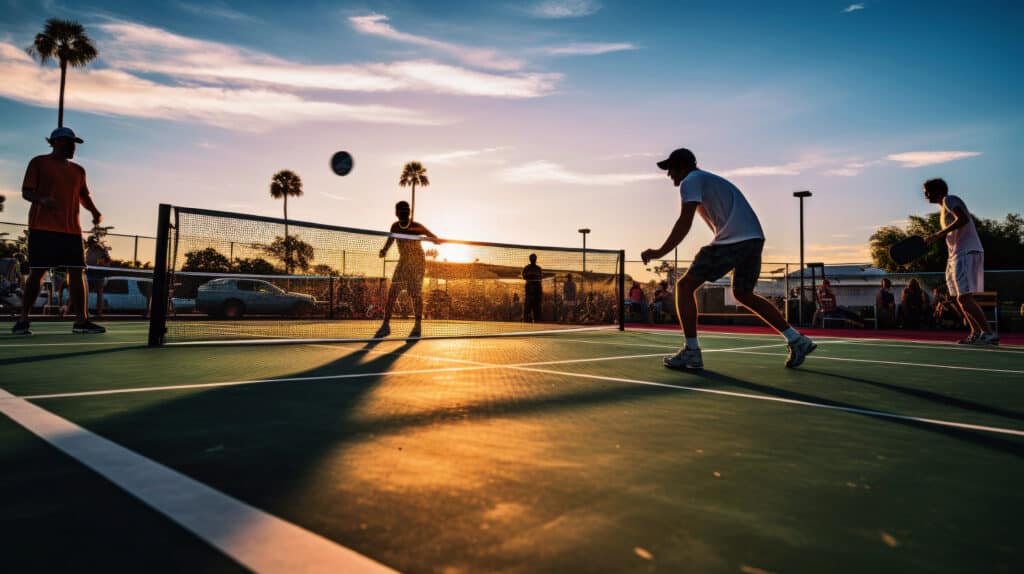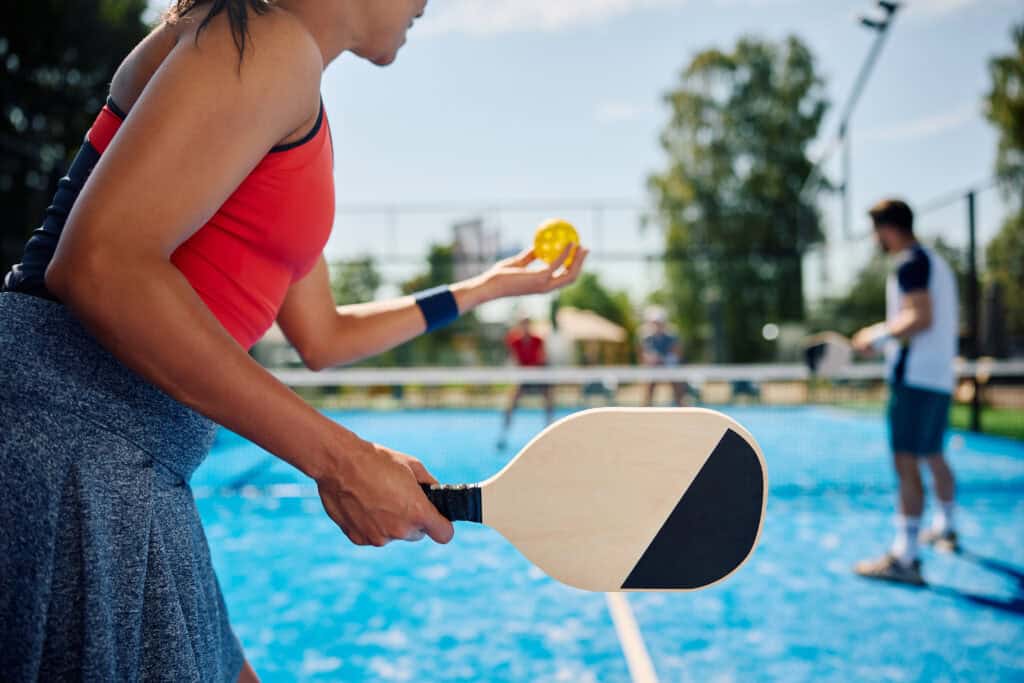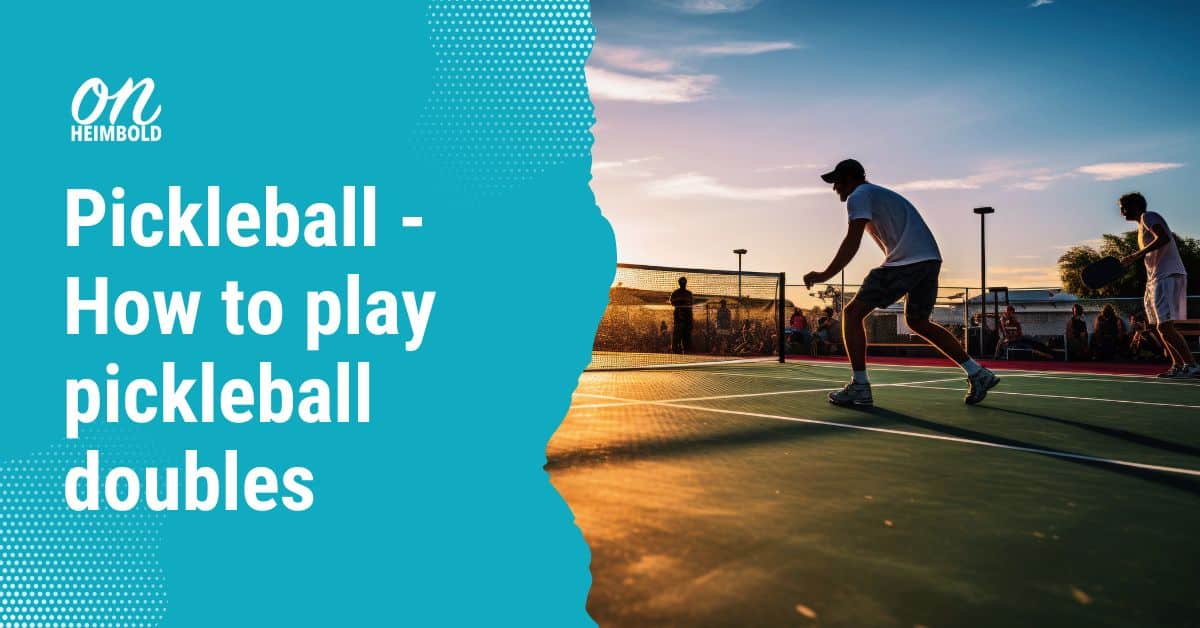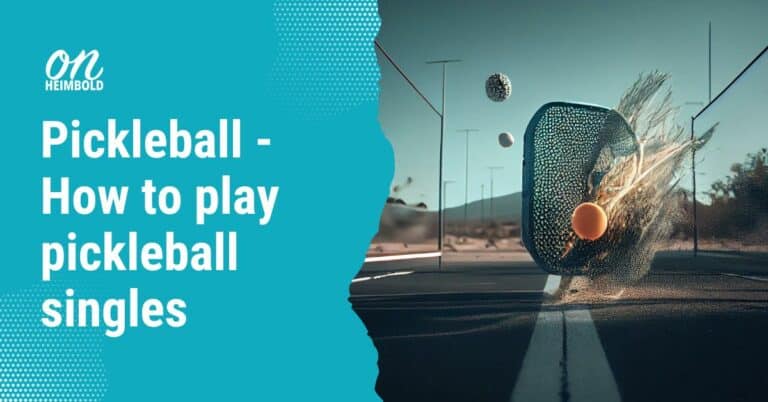Teaming Up in Pickleball: Essential Strategies for How to Play Pickleball Doubles Play
Are you ready to take your pickleball game to the next level? Whether you’re a seasoned player or just starting to learn how to play pickleball doubles, understanding the key strategies for this game format can greatly enhance your performance on the court.
Doubles pickleball requires effective communication, teamwork, and smart tactics to outmaneuver your opponents and secure victory. In this article, we will explore some of the essential strategies and techniques that can help you dominate in the doubles game.

Create an image that showcases the teamwork and coordination involved in pickleball doubles play, with players strategically positioning themselves on the court and communicating effectively to make the most of their shots. The image should convey a sense of energy and movement, with the players focused and ready for action.
The background should feature a clear view of the court, with markings indicating different zones and areas of play. Use bright colors and bold lines to highlight the players’ movements and the strategic placement of their racquets.
Key Takeaways:
- Practice patience and be selective with your shots to create opportunities for success.
- Utilize cross-court dinks in the play pickleball doubles to build patience and force your opponents to widen their defense.
- Move as one with your partner to create a strong defense and offense.
- Serve deep to put pressure on your opponents and set up third shot opportunities.
- Aim for your opponents’ feet to increase the chances of creating errors and gaining an advantage.
Practice Patience for Better Doubles Play
When it comes to playing doubles pickleball, patience is a valuable virtue. It allows you to make calculated decisions and avoid unnecessary risks, ultimately increasing your chances of success on the court.
Being selective with your shots is one way to practice patience in doubles pickleball. Instead of going for difficult shots that may result in errors, focus on hitting safe and high-percentage shots that keep the ball in play. By doing so, you can maintain control and prolong rallies, wearing down your opponents in the process.
Effective communication with your partner is also essential for practicing patience. By staying in sync and discussing your strategy, you can identify the moments when patience is needed. This could mean avoiding risky shots or patiently waiting for the perfect opportunity to attack.
Remember, according to USA pickleball rules, patience doesn’t mean being passive. It means making smart choices and recognizing when to be aggressive and when to play it safe.
By practicing patience, being selective with your shots, and maintaining open communication with your partner, you can elevate your doubles pickleball game to a whole new level of teamwork and success.
Master Cross-Court Dinks
Cross-court dinks are a powerful and strategic technique in doubles pickleball. By incorporating non-volley zone tactics into your pickleball gameplay, you can force your opponents to widen their defense, creating openings for advantageous shots, and score points. Moreover, cross-court dinks help you build patience, a vital skill in doubles pickleball.
When executed correctly, cross-court dinks require precision and control to keep the ball low and close to the net. This forces your opponents to hit upward shots, increasing the chances of their returns falling short or popping up for an easy put-away. It also gives you more time to react and position yourself for the next shot.
To master cross-court dinks, practice drills that focus on this specific technique. Set up a mini net or use the non-volley zone, or the kitchen rectangle as a target area. Keep the rallies going by exchanging cross-court dinks with your partner, aiming for consistent, controlled shots. Gradually increase the speed and intensity of your dinks to simulate real-time game situations.
| Benefits of Cross-Court Dinks in Doubles Pickleball | |
|---|---|
| 1 | Forces opponents to widen their defense |
| 2 | Builds patience and strategic play |
| 3 | Creates openings for advantageous shots |
| 4 | Increases chances of opponents’ returns falling short or popping up |
| 5 | Provides more time to react and position for the next shot |
By incorporating cross-court dinks into your doubles pickleball game, you can elevate your skills and outmaneuver your opponents. Remember to stay patient, maintain control, and practice regularly to refine your execution.
Create an image depicting two players executing cross-court dinks in a pickleball doubles match. Make sure to capture the movement and precise placement of the shots, as well as the teamwork and coordination between the players.
Use bright colors to highlight the energy and excitement of the game, and show the ball flying back and forth over the net. Focus on the players’ body language and facial expressions to convey their competitiveness and determination to win.

Move as One for Seamless Doubles Play
Moving as a single unit is a crucial strategy in doubles pickleball. To achieve seamless teamwork, it’s important to be attuned to your partner’s movements and position yourselves on the court accordingly. By doing so, you can create a strong defense and offense that leaves your opponents struggling to keep up.
Seamless doubles play involves synchronized movement and a deep understanding of your partner’s play style. Through practice and nonverbal communication, you can develop a rhythm that allows you to anticipate each other’s actions and react instinctively.
When moving as one, it’s essential to maintain awareness of the court and your partner’s positioning. This synchronization in playing pickleball enables you to cover more ground on the pickleball court, respond quickly to shots, and maintain consistent court coverage.
“Moving as one allows you to maximize court coverage, giving your opponents fewer opportunities to exploit weaknesses in your defense. It also helps create openings for offensive plays, making you a formidable force on the court.” – Sarah Anderson, professional pickleball player
Practice drills that focus on coordinated movements, such as mirroring each other’s steps and adjusting positioning in real time. This will help enhance your communication and foster a deep level of understanding between you and your partner.
Remember, doubles pickleball is a team sport that requires both skill and cohesion. By moving as one and staying attuned to your partner’s movements, you can elevate your doubles play to new heights and achieve greater success on the court.
Tips for Moving as One:
- Maintain eye contact with your partner to stay connected and anticipate each other’s intentions during a pickleball match.
- Adopt a balanced court positioning that covers both the middle and the sidelines.
- Use nonverbal cues, such as hand signals or nods, to communicate during fast-paced rallies.
- Practice maneuvering together during drills to develop synergy and coordination.
Serve Deep to Gain Advantage in Doubles Play
Serving deep in doubles pickleball is a strategic move that can give you a significant advantage over your opponents. By placing your serve deep in the court, you force your opponents to stay back near the baseline, limiting their ability to attack and putting them on the defensive.
This tactic serves a dual purpose. Firstly, it forces your opponents to stay back, making it harder for them to return your serve aggressively and put you on the back foot. This puts pressure on them and gives you control of the point from the start. Secondly, serving deep sets up third shot opportunities for your team.
When your opponents are pushed back near the baseline, they have less time to react and move to the net. This creates a window of opportunity for you and your partner to hit a third shot that places them in a disadvantageous position, allowing you to take control of the point.
To maximize the effectiveness of your deep serve, position yourself behind the baseline when serving. This gives you more time to react to your opponents’ return and adjust your position on the court accordingly.
Remember, serving deep in doubles pickleball is not just about power, but also about accuracy and placement. Aim for the back half of the pickleball court, close to the baseline, to push your opponents back to the non-volley zone and gain control of the point.
“Serving deep in doubles pickleball not only puts pressure on your opponents, but it also sets the stage for successful third shot opportunities.”
By serving deep, you force your opponents to stay back, opening up the court and setting the stage for strategic plays. This tactic requires practice and precision, but the rewards are well worth it.
Aim for the Feet for Effective Doubles Strategy
Aiming for your opponents’ feet is a strategic move in doubles pickleball. By targeting their lower body, you increase the chances of causing errors and making it challenging for them to return the shot successfully.
When you aim for the feet, your opponents are more likely to pop the ball up instead of making a clean return. This puts pressure on them and gives you an advantage in the rally. By hitting low shots, you force your opponents into difficult positions and disrupt their rhythm, leading to more mistakes on their part.
It is important to maintain a consistent distance from your partner during the game. This ensures that there are no gaps in court coverage, minimizing the chances for your opponents to exploit any weaknesses. By coordinating your movements and communicating effectively, you can effectively aim for your opponents’ feet and maximize your chances of success.
Remember, aiming for the feet is not about inflicting physical harm but strategically exploiting the weaknesses of your opponents. By hitting low shots and targeting their feet with a pickleball paddle, you create opportunities for errors and gain an edge in the match.
Conclusion in How to Play Pickleball Doubles
Doubles pickleball requires effective communication, synchronized movement, and strategic play. By practicing patience, utilizing cross-court dinks, moving as one, serving deep, aiming for the feet, and mastering other essential strategies, you can improve your doubles play and enhance your chances of winning.
Remember to always communicate with your partner and adjust your strategies based on the strengths and weaknesses of your opponents. Doubles pickleball is a dynamic and fast-paced game that demands teamwork and coordination.
Effective communication with your partner is essential to anticipate each other’s moves and respond accordingly. By maintaining synchronized movement, you can create a seamless defense and offense, putting pressure on your opponents.
Strategic play is also crucial in doubles pickleball. By practicing patience, according to pickleball guide, you can wait for the right opportunities to make your move, avoiding unnecessary risks that could give your opponents an advantage. Utilizing cross-court dinks forces your opponents to widen their defense, and aiming for their feet makes it difficult for them to return the shot effectively.
Serving deep is another strategy that can give you an advantage in doubles pickleball. By forcing your opponents to stay back near the baseline, you can set up opportunities for a successful third shot. Always be aware of the strengths and weaknesses of your opponents and adjust your strategies accordingly to maximize your chances of winning.
Maybe you are also interested in Pickleball Single, then take a look here for further insights and detailed strategies.
FAQ
How do I play doubles pickleball?
In doubles pickleball, two teams of two players each face off on a court divided by a net. The objective is to hit the ball over the net and into the opponent’s court, using only volleys (hitting the ball out of the air without letting it bounce).
The serving team starts the rally and must serve diagonally to the opposing team’s court. The receiving team must let the serve bounce once before returning it. The rally continues until a fault or error occurs. The first team to reach 11 points (with at least a 2-point lead) wins the game.
What are the rules for doubles pickleball?
The rules for doubles pickleball are similar to singles pickleball. The only difference is that each team has two players instead of one. Both teams must take turns serving, and the serving team must continue to serve until they commit a fault.
When serving, the ball must be hit underhand and below the waist. Each player must serve from the right-hand court, and the first serve of each new game should start from the right-hand side. If the serving team wins the rally, their players will alternate serving from the left and right side of the court.
What are some pickleball doubles strategies?
There are several effective strategies you can employ in doubles pickleball:
1. Practice patience in pickleball: By being selective with your shots and avoiding unnecessary risks according to pickleball rules, you can create more opportunities for successful plays and score points.
2. Use cross-court dinks: This technique forces your opponents to widen their defense and helps you build patience in the game.
3. Move as one: By being attuned to your partner’s movements and positioning yourselves on the court accordingly, you can create a stronger defense and offense.
4. Serve deep: Putting pressure on your opponents and limiting their ability to attack by serving deep.
5. Aim for the feet: Targeting shots at your opponents’ feet makes it difficult for them to return the shot without popping the ball up, increasing the chances of creating errors.
6. Master drop shots: A well-placed drop shot can catch your opponents off guard and disrupt their rhythm.
7. Use the non-volley line to your advantage: Staying behind the non-volley line while returning shots can help you control the court and minimize your opponents’ opportunities.
Remember to communicate with your partner and adjust your strategies based on the strengths and weaknesses of your opponents.



![Avoid Disaster with the [Essential] Checklist for Camping](https://onheimbold.com/wp-content/uploads/2023/05/Checklist-for-Camping-Must-Have-Items-and-Gear-for-Your-Camping-Packing-List-768x402.jpg)



